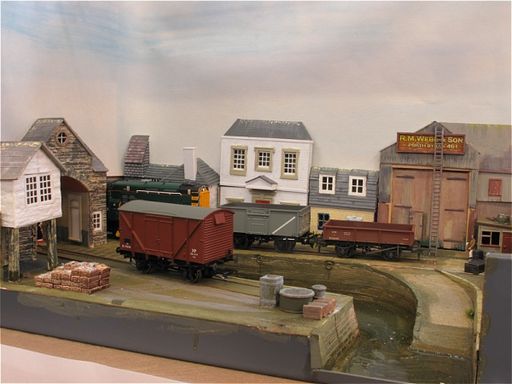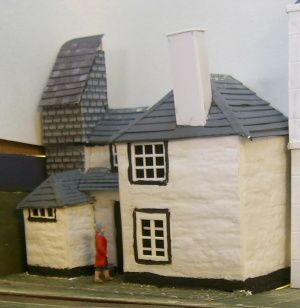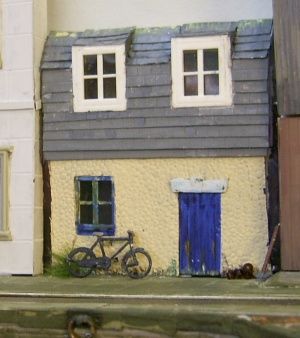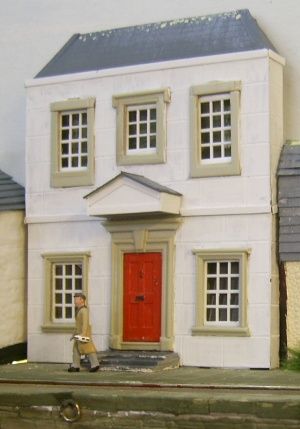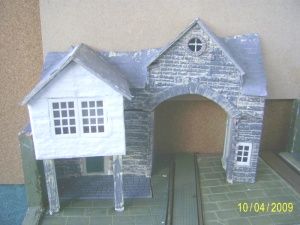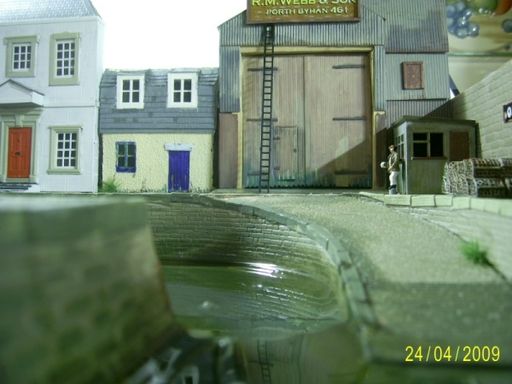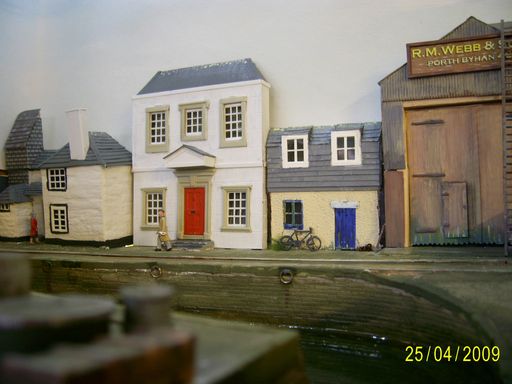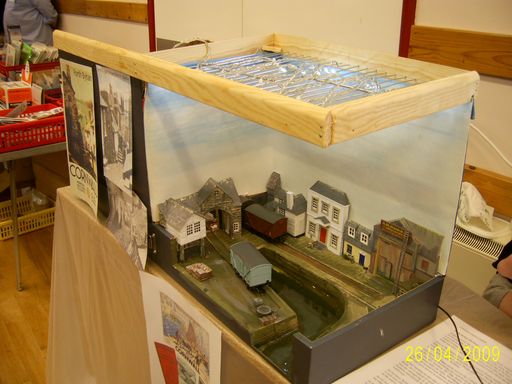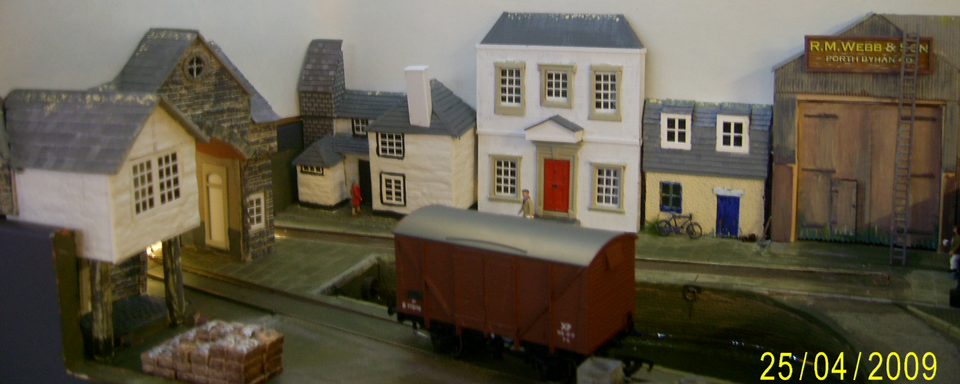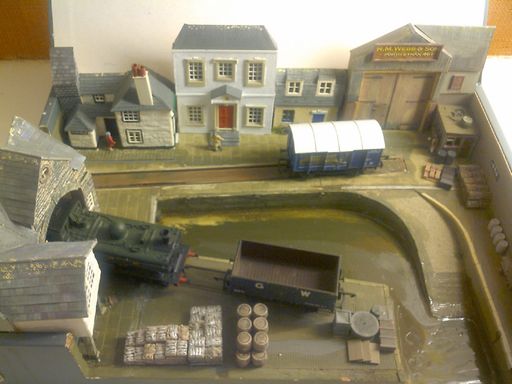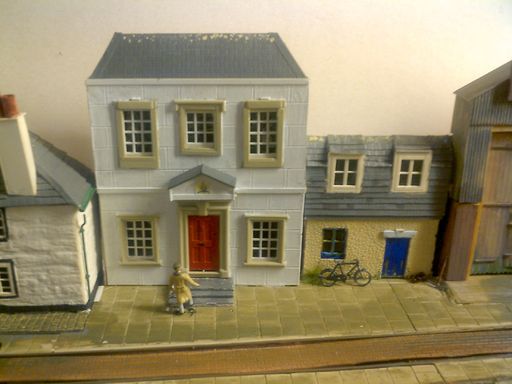Porth Byhan
Why a box file? Well at the time (December 2009) it was too cold to go in the loft to work on the main layout. I’d seen several Micro Layouts on RMweb which had given me the germ of an idea and following a family afternoon trip to Mevagissy over the Christmas holiday I decided to have a go. I could do the modelling downstairs in the warm kitchen.
For those of you who don’t know Mevagissy, a small town and harbour south of St Austell, there is a short, square quay jutting out into the inner harbour, behind which is a narrow roadway between the waterfront buildings. I’ve often thought of making a model of the area, installing an imaginary station and harbour sidings – the box file idea seemed to make sense but could concentrate on the harbour only.
The Model
I had some thick foam board and some spare track, so started playing around with the concept of a couple of siding s on a quayside. Following the ideas from Mevagissy, I devised a simple plan, complete with buildings, that would give me a representation of a Cornish harbour, plus the chance to experiment with different modelling techniques.
I also decided to post progress of the layout on RMweb – a decision I’ve not regretted as the help and encouragement I received was invaluable.
The imaginary history for the harbour had the two quays built at different times. To represent this, I used different styles of paving and stone walls. The first building I attempted was the Custom House. However, as the ground level of the harbour was halfway up the height of the box, I realised I couldn’t complete the full heigh and still shut the box lid – shutting the lid was my self-imposed restriction of the concept of the box file layout. So, I had to devise a way to fix the upper parts to the lower parts and disguise the join.
The solution was coffee stirrers. I’d used thin foam board to form the basis of the low relief buildings. Sticking short vertical lengths of the wooden stirrer between the foam board and the box side left a thin slot. I then used longer lengths of stirrer on the foam board for the upper parts of the buildings – these slid into the slots and kept the upper parts in place.
Once I’d proved this idea, the layout came on in leaps and bounds. The Custom House used large, formal window and door frames, and the cottage next door was made to look as contrasting as possible. I also wanted to create the half-wall, half-roof style windows so typical of the area. Both these buildings were fairly easy to split horizontally, and I turned my attention to the pub.
One of the best-known pubs in Cornwall is the Sloop Inn in St Ives. I took several photos, luckily without the usual throngs of holiday makers outside so was able to make a reasonable representation. In hindsight, the building is probably too small, but it sits in the corner nicely without imposing too much and gives a sense of perspective. The roof for the Lugger was left as a separate piece, the joins hidden under the eaves.
The last building at the back is the boat repair shed. This too caused me a few scratches of the head – how could I disguise the horizontal split halfway up the doors? The solution was to make the whole of the doors removeable, leaving the prototypical gap at the bottom as the join.
With two exits to the fiddle yard, I was stuck with which sort of building to disguise them. The area between the tracks was much too small to put any sort of building (I did try), so after much online discussion I created an old coaching inn converted to a fish market. This was based on another famous Cornish building, the Keigwin Arms in Mousehole, but extended with an arched passage. This proved to be the most difficult building to model as the two lower parts had be positioned carefully to match up with the top part.
Each siding track was two lengths of rail, stripped from the sleepers and glued in place. Pairs of door-catch magnets were placed between the rails, to enable uncoupling using the ’Brian Kirby Uncoupler’ idea I’d seen on RMweb.
Embossed plastic card was used for the quay paving and track infill.
Operation
Once the buildings were in, the problem of how to make a lighting gantry was tackled. I knew I’d need to see into the scenic section and that the painted backscene would be quite high as it used the open lid of the box. Also, if I made the ‘roof’ of the layout solid it would block the view. So I made a grid using a baking cooling rack, cut to length, and fitted to a wooden frame. To the rack I fixed 20 LED bulbs, bought as a Christmas tree light set which came with its own battery supply.
It was at this point I realised I’d not made any provision to power the two sidings. Fitting wires to the rails in the conventional sense was not an option as I’d left no way of accessing the underside of the track. In the end I soldered copper wire to the fiddle yard end of each rail, which was bent down over the outside of the box side.
The fiddle yard was constructed from a second boxfile, rotated 180° from the first box. Two short lengths of track were used to extend the sidings and a Peco Loco Lift used as the single cassette. The lids of both boxes were arranged to be vertical and a piece of thin MDF used as the backscene between the two. To cover the backscene, a piece of wallpaper lining paper was painted with a fading blue.
Conclusion
I was a great learning experience. I improved my modelling skills in both construction and painting, as well as leaning how to plan the order of things.
Excerpt from A Traveller’s Guide to Cornwall 1950
Porth Byhan Harbour
Walking down the main street from the town centre, we enter the quiet inner harbour at Porth Byhan, just past one of the oldest buildings in the town, the Lugger Inn. This 15th Century public house is similar in style to the more famous Sloop Inn at St Ives. A Free House, the Lugger serves local St Austell Brewery ales, plus has several guest ales each week. There is also accommodation for the weary traveller, in the quaint, oak-beamed rooms above the bar.
Next to the Lugger stands the old Custom House. At the turn of the 17th century, Porth Byhan was a major fishing port in Cornwall, but the locals were known to be not always accurate with their taxes. The Custom House also served as the first Police Station in Porth Byhan and today is still a government building.
Old Pascoe’s cottage stands next to the Custom House. Denzil Pascoe was a well-known fisherman in the town, as famous for his exploits on the sea as those off it. Many are the times he would be seen (and heard!!) wending his way home from one of the town’s hostelries, having drunk most of his companions under the table. But out at sea there was no better mariner or fisherman. He knew the waters around Porth Byhan, and indeed those from Penzance to Looe, with unrivalled intimacy and was never known to return to harbour with an empty hold.
The last building on this side of the harbour is the workshops and boat repair shed of Bob ‘Spider’ Webb. As is typical of most of the Cornish harbours, the boat repair shed is an important industry, as the seas are unforgiving in their relentless intensity. Bob Webb & Son are the fourth and fifth generation of the family to own the business and provide the same level of quality service that Cornish craftsmen are renowned for the world over.
As we leave Webb’s behind us, we now turn right on to the ‘New Quay’, although the quay and wall is now over 200 years old. Built to enclose the inner harbour, you will often see fishing nets hung on the wall to dry and for repair. As we look across the boat ramp and the narrow inlet to the inner harbour from ‘New Quay’, we see what has been called locally ‘Railway Quay’. At the landward end of this quay is the largest building in the harbour area, the old coaching inn which was once known as the Penlan Arms. This had an archway under which the coaches would be stopped to allow passengers to enter the building directly.
Built almost a full century later than the Lugger, the Penlan Arms was known for shady dealings and curious clientele who came and went at all hours of the day and night. However, with the building of the Custom House virtually on the doorstep, trade dropped off and the building became more or less disused.
When the railway arrived at Porth Byhan, the line from the station was extended down to the harbour and along the existing quay in front of the Custom House. However, the amount of fishing trade increased to such and extent that a second siding was required, and the only option was to build a new wharf into the harbour, with the rail line passing through the old coaching inn passage.
The inn was closed, and the building converted into the Fish Market. The Railway Quay is still a hive of activity today, with the surface covered in fish boxes, nets, ropes and all the other paraphernalia that goes with the fishing industry.

